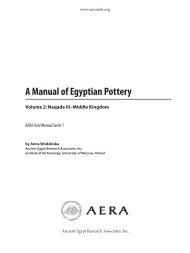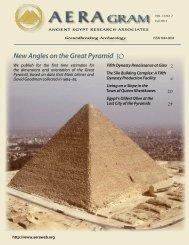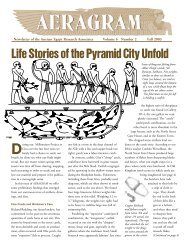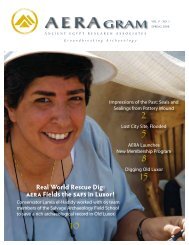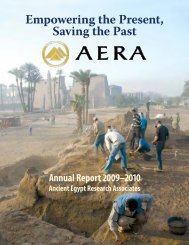The Khentkawes Town (KKT) - Ancient Egypt Research Associates
The Khentkawes Town (KKT) - Ancient Egypt Research Associates
The Khentkawes Town (KKT) - Ancient Egypt Research Associates
You also want an ePaper? Increase the reach of your titles
YUMPU automatically turns print PDFs into web optimized ePapers that Google loves.
www.aeraweb.org<br />
take over Dr. Bruno’s work for comprehensive three-dimensional<br />
documentation as quickly as possible before<br />
the restoration program was completed. For this purpose,<br />
the Saqqara Laser Scanning Survey (SLSS) team was<br />
formed largely from GLSS members, with the additional<br />
recruitment of three-dimensional laser specialists from<br />
DEVELO Solutions of Osaka, Japan.<br />
Previous archaeological work on the survey area was<br />
mainly undertaken by Cecil M. Firth and James E. Quibell<br />
with Jean-Phillippe Lauer, who comprehensively studied<br />
and restored the Step Pyramid complex for more than 70<br />
years. 1 According to Lauer, ancient builders started with a<br />
mastaba that they enlarged twice, beginning with a fourstep<br />
pyramid that was raised to the final six-step version.<br />
<strong>The</strong>ir works are indisputably seen as seminal studies on<br />
the foundations of pyramids. However, Lauer’s theories<br />
are based on his own stylized plans and sections, which<br />
do not present the actual state of the monument. <strong>The</strong> aim<br />
of the SLSS was to produce a detailed three-dimensional<br />
model of the Step Pyramid as it really is today.<br />
From May 25 to July 19, 2008, the SLSS team investigated<br />
the Step Pyramid using two types of unique laser<br />
scanners: the “Zoser Scanner,” a custom-designed portable<br />
scanner developed by DEVELO Solutions, and two<br />
of Topcon’s latest GLS-1000 laser scanners. This joint SCA-<br />
American-Japanese project has produced a three-dimensional<br />
map of every millimeter of the Step Pyramid. 2<br />
Season’s Objectives<br />
One of the aims of the SLSS in 2008 was to produce a<br />
three-dimensional model composed of “point-clouds.” In<br />
laser scanning, as the light beam sweeps over any surface<br />
it “captures” many thousands of points per second, each<br />
located to x, y, and z coordinates. A built-in or external<br />
digital camera records additional RGB color information.<br />
<strong>The</strong> point-cloud image of an ancient structure, such as<br />
the Step Pyramid, is itself an act of conservation, because<br />
it is, like all archaeological records (scale drawings,<br />
photographs, and field notes), an abstraction that<br />
represents the actual state at the time of the survey.<br />
Unlike traditional “interpreted” line drawings, the<br />
three-dimensional data are minimally interpreted “raw”<br />
data, which is a basis for versatile exploitation in post-pro-<br />
1. Firth, C. M., J. E. Quibell, and J.-P. Lauer. 1935. <strong>The</strong> Step<br />
Pyramid. 1936. Fouilles à Saqqarah. Cairo: Institut Français<br />
d’Archéologie Orientale.<br />
— Lauer, J.-P., and P. Lacau. Le pyramide à degrés, Fouilles à<br />
Saqqarah. Cairo: Institut Français d’Archéologie Orientale.<br />
2. Our team would like to thank Mr. Kosuke Ueyama (CEO of<br />
TriAx Corp.) for his generous support of the SLSS 2008 season.<br />
cessing: producing detailed three-dimensional representations<br />
and orthophotographs for two-dimensional drawings,<br />
recording the current restorations, and allowing the<br />
monitoring of long-term deterioration of the pyramid.<br />
2008 Goals:<br />
• Production of a detailed three-dimensional model<br />
of the exterior of the Step Pyramid for use as<br />
multi-purpose raw data.<br />
• Acquisition of orthophotographs of a plan and sections<br />
of the pyramid, with images being printed at<br />
a 1:100 size of the monument at 350 dpi (20,000 ×<br />
10,000 pixels).<br />
• Positioning of the exact location of the structure in<br />
terms of the Universal Transverse Mercator (UTM)<br />
coordinate system.<br />
• Production of a three-dimensional movie (1280 ×<br />
720 pixels, 30 ftp).<br />
Methodology<br />
We applied two types of laser scanning systems to the Step<br />
Pyramid. A team from Topcon, Katsunori Tomita and<br />
Kazuto Otani, employed conventional ground-fixed laser<br />
scanners, Topcon GLS-1000, for basic, overall coverage of<br />
the pyramid. However, when we scan the pyramid from<br />
the ground with the commercially available scanners,<br />
the laser beams do not reach the top sides of the stones,<br />
and when we scan from above, they miss the underside<br />
of overhanging masonry, and so each course is left partly<br />
in shadow. To avoid such unscanned areas (shadow),<br />
Takaharu Tomii, CEO of DEVELO Solutions Inc., designed<br />
and manufactured the Zoser Scanner, which is a portable<br />
multiple scanner system, simultaneously producing laser<br />
beams that even reach behind small protuberances. With<br />
this method, while surveyors scan and move at a constant<br />
speed with the scanner, accurate information for the<br />
position and the attitude of the scanner are gained by an<br />
automatic target tracking total station with an inertial<br />
navigation system (gyroscope).<br />
<strong>The</strong> Zoser Scanner was carried on the backs of professional<br />
climbers, Yoshihiko Yamamoto and Risei Sato, as<br />
they rappelled down the faces of each of the six gigantic<br />
steps of the pyramid. Four miniature scanners, two on<br />
each wing, projected infrared signals that brushed the<br />
pyramid fabric and gathered coordinates and elevations<br />
at the exceedingly fast rate of 40,000 points per second. A<br />
1/2-inch CCD digital camera accompanied each of the four<br />
miniature scanners. <strong>The</strong> four cameras mounted on the<br />
Zoser Scanner took 68,000 close-up photographs of the<br />
pyramid fabric. <strong>The</strong> scanner looked like a giant dragonfly<br />
alighted on the pyramid.<br />
64<br />
Giza Plateau Mapping Project Season 2008 Preliminary Report





